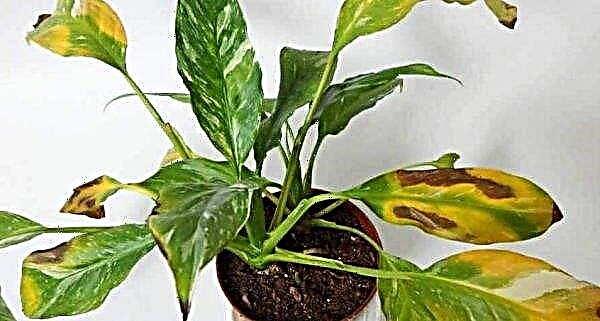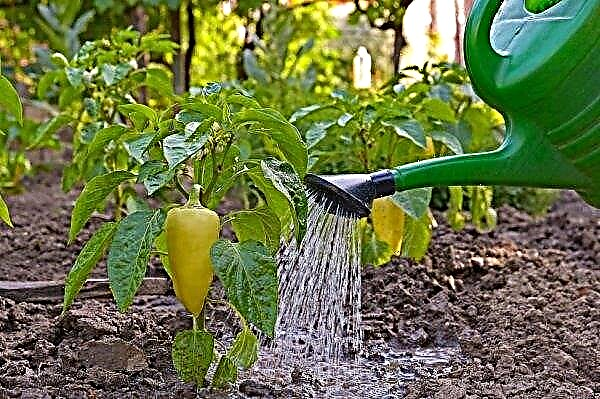Seedlings of sweet pepper are tender and fragile, the period of its cultivation is quite long, and therefore it is prone to diseases of an infectious nature. Since these diseases are contagious, they can destroy all seedlings, so growers need to know how to recognize each disease, how to deal with them and how to prevent their occurrence.
Pepper seedlings
Pepper came to us from warm tropical countries, where in summer the temperature averages + 25 ° C, and in winter + 13 ° C, and therefore in our climatic conditions it is grown through seedlings. For good growth and good health, plants need environmental and care conditions that are as close as possible to those inherent in their natural habitat.
For pepper, this is:
- heat;
- good illumination (cultivation on the eastern and southeastern windows);
- moderate humidity without drying out and stagnation of water;
- airing without drafts.
If these conditions are not observed, the seedlings begin to hurt, dangerous diseases develop on it:
- fungal;
- bacterial;
- viral.
Important! The health of sweet pepper depends on 50% of the quality of seeds and soil and 50% of proper care.
Fungal diseases
Normally, fungi always live in the soil in a small amount, which is not dangerous for plants. However, when favorable conditions arise, these organisms begin to develop excessively, causing irreparable harm to seedlings.
For the development of fungi requires:
- high humidity;
- low temperature;
- an abundance of shade and thickening of plants.

Blackleg
The disease is characterized by a change in the stalk of seedlings in the basal zone - it becomes thinner, weaker, darkens and soon dries out. This usually happens in the early stages of development - from the moment the first sprouts appear until the formation of the 2-3 first true leaves. Ill plants wilt, fall to the ground and die.
There is a black leg only under certain conditions:
- temperature differences from high to low;
- too warm and humid;
- cold soil;
- excessive hydration;
- stagnation of water;
- thickening of seedlings;
- watering with cold water.
Important! Peat or coconut tablets are ideal for growing seedlings. The black leg never develops in them. In addition, sprouts in such tablets can not be dived.
Disease control
The treatment is as follows:
- Destruction of affected shoots. They are infected and already not viable, therefore, in order to avoid further spread of the black leg, diseased specimens must be removed.
- Processing the rest of the seedlings with Fitosporin. To prepare the solution, you need to dilute 100 ml of the drug in 10 l of water. Water the plants or spray them.
- Watering with 1% Bordeaux liquid, saturated raspberry solution of potassium permanganate.
- Sprinkle the soil under the seedlings with a mixture of wood ash (1 cup) and copper sulphate (1 tsp).

Prevention
The disease is usually more difficult to treat than to prevent its occurrence.
The black leg does not hit seedlings if:
- Disinfect seeds before planting. To do this, hold the grains in a potassium permanganate solution for half an hour or treat with Fitosporin.
- To disinfect soil. You can do this in various ways: pour boiling water, calcine in the oven, treat with EM preparations, pour with a solution of potassium permanganate. However, do not plant seeds immediately after disinfection, as they will “burn out” in such soil. Before planting, let the earth “rest” for 2 days.
- Stick to temperature. The air temperature should be + 20 ° C during the day, + 15 ° C at night. Avoid sudden changes, avoid drafts, do not pour pepper with cold water.
- Provide moderate watering. Stagnant water, especially in combination with high or low temperatures, causes the development of the fungus. Watering should be moderate and regular; loosen the soil after watering so that it is light and breathable.
- Sprinkle soil on top with calcined river sand. Under such conditions, mold will not develop on the surface.
- Avoid too tight landings. Pepper seedlings need to dive on time. However, it is best to plant the seeds in separate small containers or pots, as pepper does not tolerate picking.
- Provide good lighting, placing the seedlings on the windows of the sunny side.
Did you know? 10 years - it is during such a long period that fungi provoking wilting can live in the soil.
Gray rot
The first sign is the appearance of brown, weeping spots in the basal part of the stem or on the leaves. Over time, such spots become covered with a gray coating or a thin whitish film. The cause of the occurrence is excessive humidity, stagnation of water in the soil and low temperatures. Consequences - plant growth slows down, they fade, become incapable of photosynthesis, which is why they die over time.
Disease control
If seedlings have already been affected by this disease, then you need to do the following:
- Destroy all diseased sprouts. They are contagious, and they can no longer be saved. Healthy need to be transplanted into a new, disinfected soil.
- Pour and spray the rest of the seedlings with disinfecting solutions: potassium permanganate, vitriol, Bordeaux liquid.
- Treat the plants with the Kuproksat fungicide according to the instructions.
- Use a folk remedy - garlic infusion. For its preparation, insist for 2 days 30 g of garlic diluted in 5 l of water. Sprinkle pepper with the finished infusion.

Prevention
Preventive measures are:
- observing the temperature regime;
- temperature differential prevention;
- watering at room temperature;
- lack of drafts;
- moderate watering;
- loosening the soil.
Late blight
It appears in the form of brown spots. At first they are small, but soon merge into one large spot. It affects the stem and leaves. The leaves fade and fall. The stem at the sites of constriction may break. Affected by late blight, seedlings fade, stop growing, and photosynthesis stops. Plants die. A disease develops only when contaminated soil is used or excessive moisture is present.
Did you know? Phytophthora, which hit Ireland’s potato fields in the middle of the 19th century, caused the death of 1 million Irish and the emigration of another 2 million people overseas.
Disease control
Sick sprouts must be removed immediately.
You can fight the invasion of fungi with the help of drugs:
- Previkur;
- "Fitodoctor";
- "Barrier";
- Trichodermin;
- "Barrier".

Prevention
The following methods can be used to prevent late blight disease:
- moderate watering;
- loosening the soil;
- comfortable air temperature;
- lack of high humidity;
- seed disinfection before planting;
- soil calcination;
- fertilizing with potassium and phosphorus fertilizers.
Fusarium and sclerocinia
Both diseases are known under the general name - fungal wilting. The disease usually begins with excessive humidity, heavy watering, combined with high temperatures from + 20 ° C and above. Symptoms and treatment are the same. There are no obvious signs of the disease. Seedlings for no apparent reason begin to fade. There are no spots or damage on the leaves and stems.
The reason is much deeper - in the roots. Fungi infect the root system. First, small branches of the roots, then the mycelium spreads to the remaining larger roots. Pepper nutrition is disturbed, blood vessels become clogged, the result is falling leaves, followed by withering and death. It is simple to check for fusarium and sclerotinia: cut the plant across the stem and look at the place of the cut - the stem inside will turn brown-brown.
Disease control
It is impossible to cure fungal wilting, so diseased plants need to be destroyed, and not try to save the affected specimens.
- Disinfect the soil with a potassium permanganate solution.
- Treat the soil with Planriz.
- Treat seedlings of sweet pepper means "Oksikhom" or "Previkur".

Prevention
The main reason for wilting is weakened plants, often with damaged roots, which can happen with inaccurate loosening or damage by insects. Strong sprouts with good immunity usually successfully resist fusarium and sclerocinia.
In order to prevent:
- disinfect seeds and soil before planting;
- seeds can also be treated with Fundazol.
Bacterial diseases
This category of diseases is caused by bacteria. There are usually no clear signs; they often intersect with symptoms of other diseases. Bacterial diseases can be both local and very contagious, spreading throughout the seedlings. Infection occurs from diseased plants, through contaminated soil, or when carried by insects and animals. Provided that rotting plant debris remains in the soil, bacteria can live in such soil for many years.
Black bacterial spotting
Such spotting is called black for a reason, because small leaves of black color, yellowish in outline, spread on leaves and stems. The pepper is affected by black bacterial spotting from the beginning of the first shoots. And usually ends in death.
Disease control
The methods of struggle are as follows:
- Removing plants showing signs of black bacterial spotting.
- Disinfection of soil and other seedlings with the same means that are used for fungal diseases (potassium permanganate, Bordeaux liquid).
- Prevention
- Calcination of the soil.
- Soaking seeds in potassium permanganate before planting.
- Seed treatment with Fitolavin-300.

Lightning fast bacterial wilting
In this disease, bacteria enter the plant and spread everywhere. From this, the stems and leaves turn yellow. As a result, seedlings very quickly fade and die. If an incision is made on the stem, then white mucus will flow from it.
Disease control
Control measures are as follows:
- Destruction of diseased seedlings.
- Soil disinfection.
Prevention
It is impossible to save diseased sprouts. Bacteria spread rapidly, affecting the entire seedlings, so it is much easier to prevent the development of bacteria than to fight the consequences.
To prevent the disease:
- Disinfect soil and seeds. Grains can be soaked in garlic infusion.
- Stick to temperature.
- Observe moderate watering.
- Remove weakened plants immediately, without waiting until bacteria begin to develop in them. Only sprouts with weak immunity suffer.
- Contribute to the formation of immunity with biostimulants and mineral foliar top dressing.
- Spray the seedlings with protective preparations containing copper (copper sulfate, Bordeaux mixture, Kurzat, Oksikhom, etc.).

Soft bacterial rot
The disease is similar in symptoms with lightning-fast bacterial wilting. Bacteria also penetrate into the plant, affecting all its parts. The vessels are clogged, food stops. Soft bacterial rot manifests itself in the form of discoloration of the stems and its hollowness, signs of chlorosis and necrosis appear on the leaves, and the appearance of soft watery depressions is also possible.
The disease appears only in some situations:
- when bacteria enter through damage to plants;
- in conditions of high humidity and heat;
- in the absence of ventilation.
Disease control
Control measures are as follows:
- Destruction of diseased plants.
- Disinfection of the remaining seedlings and soil.
- Removing any remnants of infected seedlings from the ground, as they will serve as a hotbed for the spread of infection.
Prevention
You can prevent the disease by the following measures:
- Disinfection of the earth.
- Seed dressing.
- Compliance with temperature and irrigation.
- Loosening the soil.
- Regular ventilation without drafts.

Bacterial pepper cancer
Another disease that affects seedlings of sweet pepper. It is not treated and is very dangerous. It appears in the form of spots on the leaves. At first they are small in size, have an irregular shape. They are brown in color, but the middle is lighter. During the course of the disease, small spots merge into large ones, up to 3 cm in diameter. On large spots, in turn, a crust forms.
The cause of the development of the disease are:
- high temperature contents from + 25 ° C to + 35 ° C;
- excessive humidity, which is often inherent in greenhouse shelters;
- sprinkling method;
- dense landings.
Bacteria are transported in various ways:
- insects
- tools
- hands of people.
Disease control
Before removing diseased plants, you must first process and disinfect healthy seedlings. For this, any copper-containing preparations are suitable.
Prevention
For prevention, all the above measures are used. The most effective will be to use "Fitolavin-300" for seed treatment before planting.
Viral diseases
Viruses are dangerous, they cause irreversible changes in carrier cells, and the diseases caused by them are not treatable. Viruses spread through vectors - insect pests that eat delicate pepper greens.
Tobacco mosaic
The disease causes the tobacco mosaic virus - TMV. It can be transmitted from plant to plant, through contaminated soil, seeds, equipment. However, most often it is distributed by insects: plant-eating mites, aphids, ants. The disease appears on the leaves in the form of a mosaic or marble pattern of dark and light green spots.
The highlighting of the sites occurs due to the fact that the virus, penetrating into the cells, causes their pathological changes. The mosaic pattern darkens over time, the leaves turn black, become clotted and ultimately fall off.
Disease controlDid you know? The first virus detected is the tobacco mosaic virus. It was discovered at the end of the 19th century by the Russian microbiologist Ivanovsky, who discovered that tobacco plants infect organisms that are much smaller than bacteria.
The disease is incurable. Sick sprouts can be removed and burned, however, most likely, the virus has already been transmitted to the remaining seedlings, because of which it will all die.
Prevention
To prevent the appearance of the tobacco mosaic virus in the following ways:
- To disinfect seeds and the earth.
- To process soil with disinfecting compositions.
- Use only clean tools.
- Gently dive peppers, as the virus penetrates the lesions.
- Fight pests with insecticides in a timely manner.

Stolbur
The disease is also known as phytoplasmosis. It affects the root system, causing it to rot. For this reason, plants do not receive enough nutrients, metabolism is disturbed. As a result, growth slows down and a phenomenon such as dwarfism arises. Leaves become small, they dry out, curly, turn yellow.
Infection with columnar occurs mainly through cicadas - pests that drink plant juices. During nutrition, the circus pierce the surface of the leaves. It is in these punctures that the virus penetrates. The cicadas are most active in May, so during this period there is the greatest likelihood that the seedlings will become ill. Aphids, spider mites, thrips also carry stolbura.
Disease controlImportant! None of the varieties of pepper have good immunity to withstand stolbury.
There is still no cure for this disease that would be effective enough. All the previous measures can be used, however, the cause of the spread of the viral infection lies in the insect vectors. So, the fight should be aimed primarily at preventing their appearance on your seedlings of pepper.
Prevention
Preventive measures include treating peppers with insecticides to prevent pests. The diseases to which pepper seedlings are exposed, whether they are fungal, bacterial or viral, are most often incurable. Regardless of what kind of disease struck the plants, diseased sprouts must be destroyed, and healthy ones should be treated with protective agents. However, the success of the cultivation primarily lies in the prevention - disinfection of seeds and soil before planting, fertilizing for strong immunity, observing the proper cultivation conditions necessary for pepper.
The diseases to which pepper seedlings are exposed, whether they are fungal, bacterial or viral, are most often incurable. Regardless of what kind of disease struck the plants, diseased sprouts must be destroyed, and healthy ones should be treated with protective agents. However, the success of the cultivation primarily lies in the prevention - disinfection of seeds and soil before planting, fertilizing for strong immunity, observing the proper cultivation conditions necessary for pepper.












